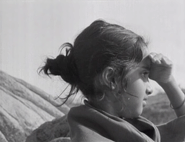Ritwik Ghatak’s films are deeply haunted by the specter of the Partition of Bengal in 1947, and this sense of dislocation and self-inflicted human tragedy created by artificially imposed social division casts a pervasive sentiment of despair, instability, and perpetual exile through all the rended families and uprooted ancestral communities of Subarnarekha. Opening to the chaotic image of a pair of young, displaced teachers, Haraprasad (Bijon Bhattacharya) and Ishwar (Abhi Bhattacharya) inaugurating a makeshift village school at a refugee colony that has been established on the grounds of landowner’s estate, while a low caste woman, seeking alms nearby, is forcibly separated from her son, Abhiram (Sriman Tarun) when she is rounded up into a truck and summarily ethnically cleansed from the colony by the landowner’s hired thugs under the guise of religious orthodoxy enforcing caste segregation, the turbulent – and ultimately irrevocable – separation between mother and child serves as a potent metaphor for the trauma of the Partition itself, as Bengal is torn apart by religious and social sectarianism in the aftermath of the country’s independence from the British. Ghatak illustrates the integrality of history to the interconnected destinies of Ishwar’s communal family, initially, through the collapsed hope for reunification embodied in the idealistic Haraprasad’s coincidental lament upon reading the news of Mahatma Gandhi’s death – “Hey Ram!” (Oh, God!) – the exclamation commonly believed to be Gandhi’s own last words upon his assassination, and subsequently, in Ishwar’s conversation with his college friend, Rambilas (Pitambar), a wealthy businessman who inherited a foundry from his late father, as Ishwar comments on his dramatic change in fortunes from privileged student to orphan and caretaker of his younger sister Sita (Indrani Chakrabarty) after only six intervening years by reinforcing the contextual timeframe as 1942 through 1948, a profoundly critical period (with particularly great consequences for Bengal) that marked the birth of the ‘Quit India’ movement (1942), the Bengal Famine (1943) directly caused by the escalation of the Pacific War (a man-made catastrophe that is poignantly realized in Satyajit Ray’s Distant Thunder), national independence (1947), the Partition (1947), and the assassination of Gandhi (1948).
Similarly, the Subarnarekha River (translated as the “Golden Line” River because of its proximity to rich ore deposits) becomes an implicit reflection of the inescapable social (and economic) disparity and cultural marginalization that continues to afflict the displaced refugees of the Partition, as Ishwar, seeking to find a new home and a better life for his young sister, accepts Rambilas’ offer to work at the foundry in exchange for a small wage and company-furnished housing on the other side of the eponymous river. Leaving the colony – and in essence, abandoning the dream of reunification – with Sita and Abhiram, for whom he had assumed guardianship until his mother is located, Ishwar invariably settles into a life of middle-class comfortability when he is subsequently promoted as manager and given a minority stake in the company. But Ishwar’s financial stability also betrays a passivity to the profound changes occurring within his own home, an indifference that is reflected in Ishwar’s filial criticisms over the melancholy expressed by a now grown Sita (Madhabi Mukherjee) through her sorrowful ballads, and university student Abhiram (Satindra Bhattacharya) through his unpublished manuscripts that reveal a deeply harbored (and overtly autobiographical) longing to reconnect with a lost mother and an adrift sense of place, as well as through their increasingly inescapable affection towards each other. It is this pervasive complacency (if not outright willful ignorance) that inevitably lies at the core of Ghatak’s impassioned social criticism on the fateful dynamics that led to the culturally self-inflicted tragedy of the Partition – an inextricable pattern of self-interest, insensitivity, and political apathy from the Bengali middle-class that not only enabled ideological fanaticism and sectarianism to shape the landscape of a post-colonial Indian nation, but also rendered the very idea of home as a sentimental place on an elusive other side that, like the distant, opposing banks of the Subarnarekha River, symbolically represents an idealized, and intranscendible, elsewhere.
© Acquarello 2007. All rights reserved.
